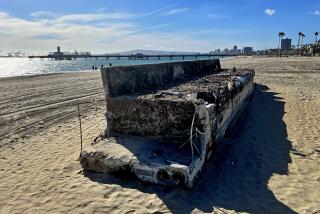Firm Turns Hazardous Waste Into Street Paving
- Share via
“Burn it . . . bury it . . . and forget it” has been the rallying cry of the hazardous waste disposal industry far too long, says Jack M. Kent.
In Morgan City, a seaport west of New Orleans on the Gulf of Mexico’s Intra-Coastal Waterway, Kent’s firm, Marine Shale Processors Inc., is turning hazardous waste from California and other states into a construction aggregate safe enough for playgrounds, tennis courts and streets.
He said in a telephone interview from his headquarters in the New Orleans suburb of St. Rose that his firm was originally formed to process oil drilling mud, but he quickly discovered that it wasn’t economical to use the thermal oxidation method for this activity.
“The name of my company reflects the fact that we were formed to process off-shore shale or drilling mud,” he added. “I’ve been in the aggregate business since 1969, supplying asphalt aggregate for parking lots and airport runways, so I decided to process hazardous waste into a safe aggregate.”
As far as Kent knows, his firm is the only one in the world that processes hazardous waste, such as paint solvents, chemicals and soil into a useful, environmentally safe product. It has a permitted capacity of 1,000 tons an hour, but it currently is running at about 400 to 450 tons an hour, enough to produce a monthly dollar volume of nearly $3.5 million, he said.
“American science and American industry have got to stop trying to develop bigger and better ways to bury our garbage,” Kent said, reminding those Southland residents who have been following the news recently, that fewer and fewer dump sites are open for an ever-increasing mound of solid waste.
Nineteen California firms, including 16 from the Southland, have discovered that it is at least 50% more economical to ship their toxic waste to Louisiana than to have it processed in California.
Among the firms are McDonnell Douglas Astronautics Co., Huntington Beach; Betterbilt Chemicals, Santa Fe Springs; California Chemical Disposal, Wilmington, Benco Sales Inc., Fontana, and A & S Environmental, Los Angeles.
Oil Patch Collapse
Kent arrived in Morgan City in 1984, just in time to see the beginning of the economic slide of the Oil Patch states of Louisiana, Texas and Oklahoma. Marine Shale Processors was incorporated in September, 1984, and Kent purchased an old lime plant in the nearby community of Amelia.
While he isn’t claiming that recycling of hazardous waste into useful industrial products will immediately turn around the devastated economy of Morgan City and Louisiana in general, Kent believes that the potential is there for a new industry that will be relatively unaffected by ups and downs, such as petroleum.
At the Marine Shale Processing complex, a gigantic steel tube nearly as long as a football field, dwarfs the other buildings. The thermal furnace is a kiln that “cooks” the incoming waste at temperatures around 2,500 degrees Fahrenheit as the waste travels through the tube.
According to tests by the federal Environmental Protection Agency (EPA), the white steam rising from the emission stack is 498% purer than the EPA’s allowable level for industrial emissions, Kent said.
Too, the EPA, after a string of inspections, has ruled that the facilities, operations and products of Marine Shale Processors “pose no imminent or substantial threat to the environment or to public health,” he said.
Making Waste Useful
Laboratory tests by the EPA and the Louisiana Department of Envirionmental Quality of the construction aggregate produced by the firm confirm that it is non-toxic and safe for all applications, according to Kent. And Kent cites history to show that one generation’s waste products can easily become another generation’s basic commodity.
He cites oil as one example and manure as another: For almost a century after oil was discovered in Pennsylvania, production companies burned off the smelly, hazardous and highly lethal waste product of oil wells . . . until someone changed the name of the product to natural gas.
Profitable utilization of manure thousands of years before was a comparable bright idea, Kent said.
“That Babylonian farmer could have kept on piling the stuff into a stinking mountain behind his barn,” he said. “Instead, he used his brains and a rudimentary knowledge of agriculture to transform manure into fertilizer. Incinerators, landfills, and the rest are just our modern way of piling the waste behind the barn.”
More to Read
Sign up for Essential California
The most important California stories and recommendations in your inbox every morning.
You may occasionally receive promotional content from the Los Angeles Times.










